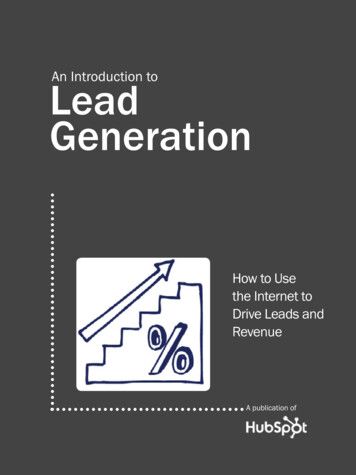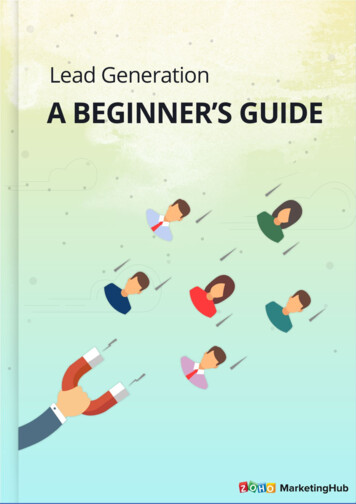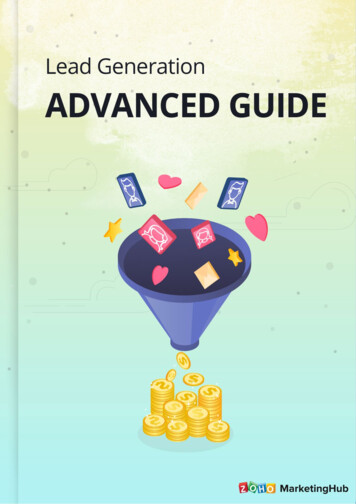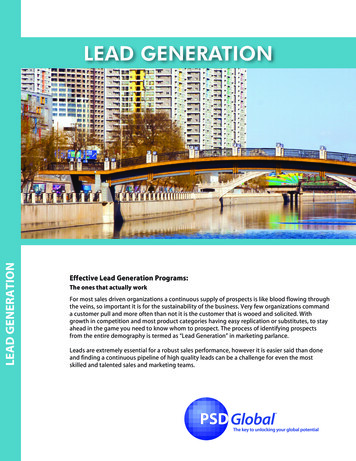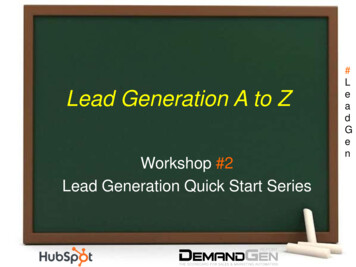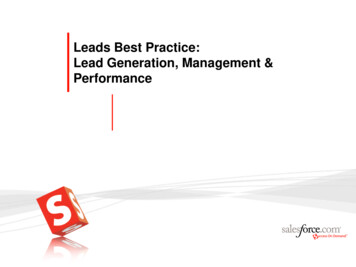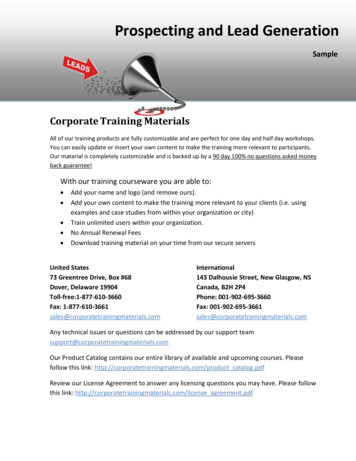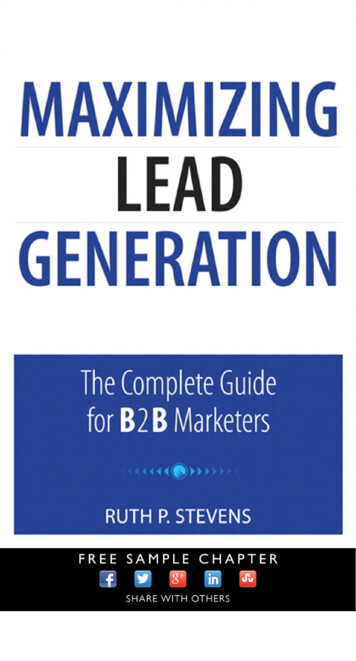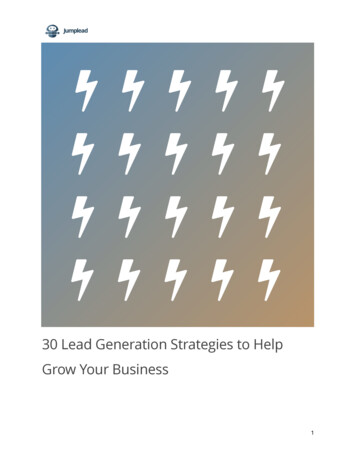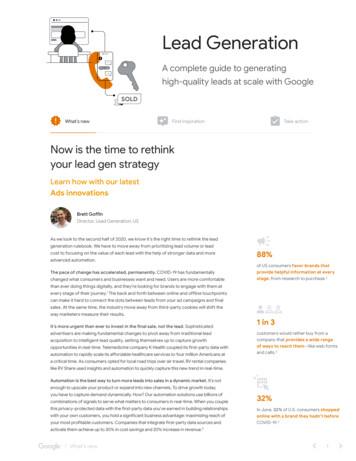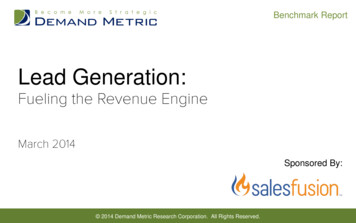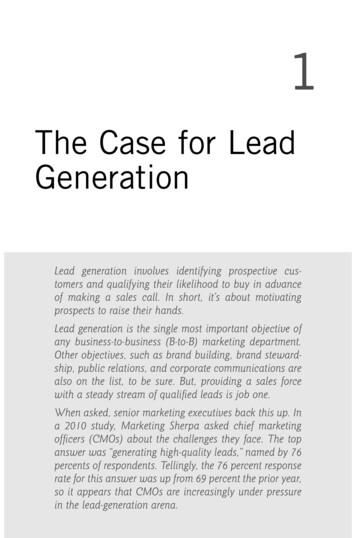
Transcription
1The Case for LeadGenerationLead generation involves identifying prospective customers and qualifying their likelihood to buy in advanceof making a sales call. In short, it’s about motivatingprospects to raise their hands.Lead generation is the single most important objective ofany business-to-business (B-to-B) marketing department.Other objectives, such as brand building, brand stewardship, public relations, and corporate communications arealso on the list, to be sure. But, providing a sales forcewith a steady stream of qualified leads is job one.When asked, senior marketing executives back this up. Ina 2010 study, Marketing Sherpa asked chief marketingofficers (CMOs) about the challenges they face. The topanswer was “generating high-quality leads,” named by 76percents of respondents. Tellingly, the 76 percent responserate for this answer was up from 69 percent the prior year,so it appears that CMOs are increasingly under pressurein the lead-generation arena.
2Maximizing Lead GenerationFurthermore, the other issues keeping CMOs up at night are also heavily aboutleads. In Table 1.1, you can see the survey results in detail.Table 1.1CMO ChallengesWhich of the following marketing challenges are currentlymost pertinent to your organization?Generating high-quality leadsMarketing to a growing number of people involved in thebuying processPercent of respondents, 201076%45%Generating a high volume of leadsMarketing to a lengthening sales cycleGenerating public relations “buzz”Generating perceived value in “cutting edge” productbenefits39%39%39%37%Competing in lead generation across multiple media32%Source: Marketing Sherpa B-to-B Benchmark SurveySo, it’s fair to conclude that lead generation is critically important to business marketers. But, despite the importance of leads, the term “lead” is often misunderstood.Defining Terms: What a Lead Is and What It Is NotA lead is a prospect that has some level of potential of becoming a customer. Weneed to distinguish a lead from a business inquiry or from a mere list of names,with which leads are commonly confused. Mailing lists or contact lists of businessprospects are often presented as “lead lists,” a misnomer that generates not onlyconfusion but even ill will in the world of business marketing. A passive list ofprospects (or, more appropriately, suspects) does not deserve to be called a list ofleads.The same holds true for inquirers. Simply because someone has expressed a modicum of interest in your product or your company does not mean that person orthat company is ready, willing, or able to buy. But an inquirer has plenty of value.You can continue to communicate, nurture that interest, and keep a relationshipgoing until a sale is imminent.Marketers must deliver a lead to the sales team only when the lead is truly qualified, and they must do so by criteria developed in consultation with the sales force.Consistent delivery of qualified leads that convert satisfyingly to sales and meetsales quotas—that is the hallmark of successful B-to-B lead generation.
Chapter 1The Case for Lead Generation3The process of lead generation is fairly straightforward; however, it does involve along and somewhat complex series of steps, beginning with a series of outbound andinbound contacts to generate the inquiry and qualify it, to handing the lead to thesales organization, and then tracking the lead through conversion to sales revenue.The secret to success is in a focus on business rules and processes, as boring as thatmight sound. Lead generation and management are not the glamorous creativesides of marketing. They are more about developing the rules, refining them, testing, tracking them, and continuous improvement. This is not to say creativity cannot have impact. It can.TipThe company with the best lead-generation process, executed consistently,is the one with the true competitive advantage.Many parties are involved in the process, both internal to the company and external. Each has a role and each has a share in the credit for the results. To be successful in this kind of business environment, marketers must focus on fairly elaborateplanning and process development, regular consultation with sales, disciplinedmeasurements and analysis, and constant communication with everyone.There is a certain amount of disagreement about the “right” meaning of variousterms in lead generation. In fact, there is no right or wrong. Companies and cultures tend to create their own definitions, which are passed down internally frommanagement generation to generation. Usage also varies from industry to industry.Following are the definitions of terms as they are used in this book: Prospect. An individual or company that is likely to need your productor services, but has not bought from you yet. Customer. An individual or company that has made a purchase fromyou. Inquiry. The first inbound contact from a prospective customer. Itmight come in “over the transom” or, more likely, from a campaign. Theinquiry might also come from a current customer who seeks a refill, areplacement, an upgrade, or a new product. Response rate. The rate at which prospects or customers respond to anoutbound campaign. It is calculated by dividing the number ofresponses by the number of prospects promoted. After they arereceived, the responses are called inquiries.
4Maximizing Lead Generation Lead (also called qualified lead). An inquiry that has met the agreedupon qualification criteria, such as having the right budget, decisionmaking authority, need for the product or service, and readiness tomake the purchase in a suitable amount of time. After an inquiry hasbecome a qualified lead, it is ready to be worked by a sales person. Qualification. The process by which you establish whether the inquiryis qualified to become a lead. Qualification rate. The rate at which inquiries migrate to qualifiedleads. It is calculated by dividing the number of qualified leads during aperiod, or from a particular campaign, by the number of inquiries inthe period or from the campaign. Nurturing. The process of moving an unqualified inquiry to the pointwhere it becomes qualified. Some inquiries qualify right away. Many,however, need some nurturing via outbound communications until theprospect is entirely ready to be contacted by a sales person. Conversion. When a lead becomes a sale. Closed lead. A lead that has converted into a sale. Conversion rate.The rate at which qualified leads convert to sales. It iscalculated by dividing the number of closed leads by the number ofqualified leads delivered to the sales force.How Lead-Generation Campaigns Differ from OtherTypes of Marketing CommunicationsLead generation is a different animal from general advertising or marketing communications. The biggest difference is that lead generation relies on direct marketing, also known as direct-response marketing communications. Direct marketingcomprises a set of marketing tools, approaches, and activities that are targeted,measurable, and driven by return-on-investment (ROI) considerations. But the keydifference is that direct marketing’s goal is to motivate an action. The action can beanything from a click, to a phone call, to a store visit—whatever the goal of themarketer is.Based on customer information captured and maintained in a database and using avariety of analytical and communications techniques, direct marketing provides theunderpinnings of some of today’s most effective marketing approaches. Theseapproaches include e-commerce, data mining, customer relationship management(CRM), and integrated marketing communications. But the major contribution that
Chapter 1The Case for Lead Generation5direct marketing makes to the business marketing equation is generating leads for asales force, whether a field sales team, inside sales, or an outside sales resource like adistribution channel partner or representative.B-TO-B DIRECT MARKETING ISBIG BUSINESSThe Direct Marketing Association publishes some interesting statistics on thesize and value of direct marketing in business markets. Consider these fromThe DMA 2010 Statistical Fact Book: B-to-B direct marketing spending in all media channels in 2010 was 74.6 billion. Spending growth rate (CAGR) between 2009 and 2014 is expectedto be 4.9 percent for B-to-B, compared to only 4 percent for theconsumer direct marketing spend. B-to-B sales driven by direct marketing in 2010 represented 786billion. Sales growth CAGR in 2009 to 2014 is estimated at 5.4 percent,compared to 4.9 percent in consumer. An estimated 3.9 million people were employed in B-to-B direct marketing in the U.S. in 2009. This is big business, in every sense ofthe word.Besides direct-response marketing, there are two additional ways that lead generation is different from other forms of marketing communications. For one thing,lead generation is about quality versus quantity. Sales people are an expensiveresource for a company. The job of lead generation is to make them more productive. So, it’s not about a wide reach and a lot of volume. In fact, fewer, better leadstrump more, lower quality leads every time.Second, lead generation tends to be down there on the ground. It’s about helpingsales, driving results in the field, and connecting to revenue. Often, lead generationis part of a function called field marketing and is seen as a more tactical set ofactivities than the strategic marketing that goes on in corporate communications, inbrand building, and public relations. Some lead generators get miffed about theirrelatively tactical role, feeling that they are somehow viewed as lesser beings thanthe general marketers who think about so-called bigger picture marketing. This is asubject of ongoing debate in the B-to-B world. In my view, however, anything that isthe primary occupation of 76 percent of CMOs is certainly worth a lot of respect.
6Maximizing Lead GenerationThe Lead-Generation ProcessLead generation is, frankly, more a science than an art. It is based on process, bestpractices, and continuous testing and improvement. As noted, the company withthe best process wins. Smart marketers focus on each step in the process, lookingfor ways to make it more efficient. The end result pays off in lower costs and higherconversion rates to sales. The following sections describe the steps, in planningorder, but not necessarily in order of importance (they are all important). Each ofthese process steps is discussed in detail in this book.Inquiry GenerationReaching out to prospects and generating an initial response begins the process. Tobreak inquiry generation down, you can look at it, too, as a series of steps:1. Set campaign objectives. Most lead-generation campaigns select fromthe following objectives: The number of leads expected. The degree of qualification. The time frame during which they will arrive. The cost per lead. Lead-to-sales conversion ratio. Revenue per lead. Campaign ROI or expense-to-revenue ratio. Choose one primary and no more than two secondary objectives,and make them very specific.2. Analyze and select campaign targets. The tighter your targeting, thehigher your response is likely to be. Current customers, of course,respond better than cold prospects. In fact, some companies find thatmuch of their lead-generation work involves finding new opportunitiesin accounts they already have relationships with. So, it’s not coldprospecting, but it’s still an effort to generate business for new products,new buyer groups, or additional divisions or business units in theaccount. That said, most B-to-B marketers focus on entirely newaccounts for their lead-generation programs.3. Select campaign media. For generating leads among new prospects,the best choices are SEM, telemarketing, and direct mail for ongoing
Chapter 1The Case for Lead Generation7campaign work. Trade shows, web-based lead generation, and referralmarketing programs can also be effective. Among inquirers and currentcustomers, you will find telephone and email most productive, telephone being more intrusive and email being the less expensive option.4. Develop a message platform. The platform is the key benefit thatappeals to the target audience. Your response improves if you keep themessage simple and focus on a single benefit.5. Develop a campaign offer. This subject is discussed in detail inChapter 6, “Campaign Execution.” For now, suffice it to say that thepurpose of the offer is to motivate the target prospect to respond withan indication of interest in your product or service. Don’t be fooled intothinking that you can get away without a motivating offer of some sort.You can’t.6. Create communications. Unlike general advertising communications,the copy is the most important element of your lead generation creativetreatment, so use a professional direct-response copywriter who hasB-to-B experience.7. Plan fulfillment materials. Speed is of the essence. Studies show thatthe faster the fulfillment materials are received, the more likely the leadis to be qualified. The need is still fresh, and competitors are less likelyto be in the way. As a rule of thumb, inquiries should be fulfilled nolater than 24 hours after receipt, if using printed materials, and instantaneously if using a landing page with downloadable materials.Response PlanningPlanning for response management is a critical and sometimes sorely neglectedpart of preparing a lead-generation campaign. You will not regret the effort you putinto ensuring your prospects’ responses are properly handled and tracked. In fact,some would argue that if this work is not done right, you are throwing your marketing investments out the window.Start response planning early in the campaign-development process. Make sure youhave a unique code that identifies responses from every outbound communication.This can be a priority code, a special toll-free number, an operator’s name, a uniqueURL, anything. Offer multiple response media
Lead generation is the single most important objective of any business-to-business (B-to-B) marketing department. Other objectives, such as brand building, brand steward-ship, public relations, and corporate communications are also on the list, to be sure. But, providing a sales force with a steady stream of qualified leads is job one. When asked, senior marketing executives back this up. In a .
